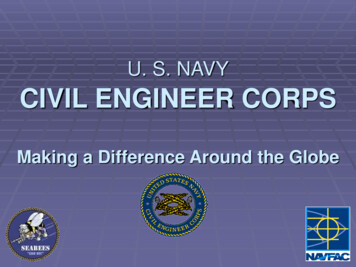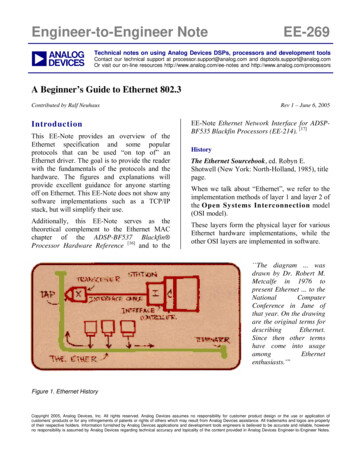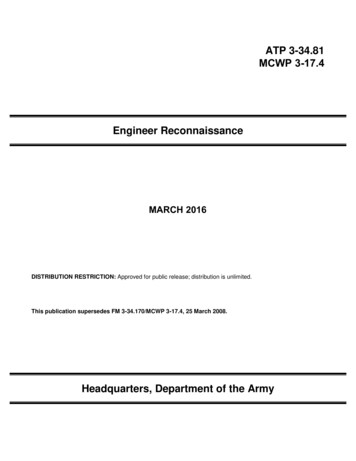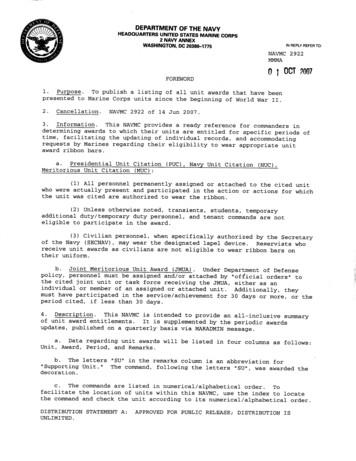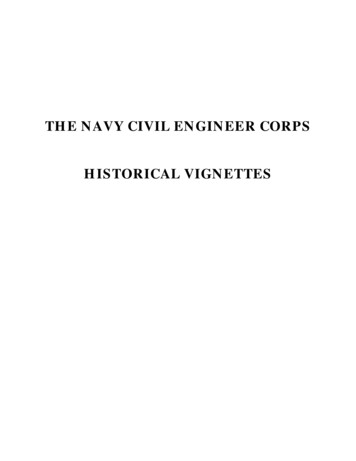
Transcription
THE NAVY CIVIL ENGINEER CORPSHISTORICAL VIGNETTES
INTRODUCTIONHistory is the sum total of individual accomplishment. If we are, therefore, to know the historyof the U.S. Navy’s Civil Engineer Corps, we must know and understand the men that made thathistory.Consequently, this collection of historical vignettes focuses primarily on individuals and theirdeeds, although organizational developments and individual projects are not neglected -- forwithout knowledge of the latter there would be no historical context to make comprehensible theformer.The newly-established Navy needed a shore establishment to build and maintain its vessels andsupport its personnel in times of peace and war; this single fact led eventually to the hiring ofcivil engineers, the establishment of a staff corps of civil engineers, and finally the creation of aNaval Construction Force officered by members of this staff corps.The following pages will trace the history of the Civil Engineer Corps, through the interaction ofmen and events, from almost the very origins of the U.S. Navy down to the present. The readerwill meet the first civil engineers who built for the Navy, see the establishment of the Bureau ofNavy Yards and Docks which would eventually evolve into today’s Naval Facilities EngineeringCommand, witness the transformation of the Navy's first civil engineers into commissionednaval officers and follow these officers through two major and three minor wars -- one of whichsaw the creation of the famed Seabees.The present is an ever advancing line; the events of a second ago are already history. In order tounderstand where we are, and where we are going, we must know where we have been. That isthe purpose of this collection -- to tell today’s Civil Engineer Corps officers who theirpredecessors were and what they did.
THE FOUNDING FATHERS:THE FIRST CIVIL ENGINEERS WHO BUILT FOR THE NAVYBefore the establishment of the Navy Civil Engineer Corps, before even the establishment of theBureau of Navy Yards and Docks, two prominent civilian civil engineers built shore facilities forthe Navy.BENJAMIN HENRY LATROBE (1764-1820)The first to do so was Benjamin Henry Latrobe, a noted architect and civil engineer of the firstyears of the nineteenth century. Born the son of a Moravian minister of French descent inYorkshire, England, Latrobe was educated in both England and Germany. In 1793 he beganworking as an engineer and architect in London. In 1796, three years after the death of his wife,Latrobe immigrated to the United States with his two children, and continued working as a civilengineer.It was said that Latrobe “.found architecture in America a polite accomplishment of gentlemenamateurs and left it a profession, with professional standards and practices, largely in the handsof his own pupils.” Apprenticeship with Latrobe constituted the first important professionaltraining in engineering and architecture in America, and his style dominated building in the U.S.until the Civil War.In 1798 Latrobe designed and built the new Bank of Pennsylvania in Philadelphia and a citywater supply system for the same city, the first in America.In 1802 President Thomas Jefferson called Latrobe to Washington to make drawings, surveys,and estimates for a dry dock to keep the Navy's twelve frigates seaworthy. Congress, however,refused to appropriate the necessary 417,276 so the dock was not built. In 1803 PresidentJefferson created the post of Surveyor of the Public Buildings for Latrobe with an annual salaryof 1,700. Latrobe's first assignment was the construction of the south wing of the Capitol,which contained the Hall of Representatives.In 1804 Latrobe received the title "Engineer of the Navy Department" (the entire departmentconsisted of the Secretary of the Navy and three clerks!) and prepared plans for the developmentof the Washington Navy Yard. The yard he built was burned to keep it out of the hands of theinvading British in 1814; however, his 8th Street (Main) gate still exists and the basic layout ofthe yard remains his.In 1807 Latrobe produced designs for the remodeling of the White House; and the followingyear made the plans for a Marine Hospital. In 1809 he also drew up plans for the developmentof navy yards at New York and Norfolk, Virginia.Following a private venture which failed, Latrobe returned to Washington in 1815 to take chargeof rebuilding the Capitol building, burnt by the occupying British during the War of 1812. Heresigned this position in 1817 over differences with the Capitol commissioner. This was his lastwork for the federal government.While Benjamin Latrobe has the distinction of being the first civil engineer to carry out shorefacility construction projects for the Navy, he was not really a Navy civilian employee. Instead,he was commissioned to execute specific projects for the Navy in the manner of one of today'sarchitect-engineer contractors.
LOAMMI BALDWIN (1780-1838)Although Latrobe produced development plans for navy yards at New York and Norfolk, nonewas built until years after his death. Finally, in 1826 Congress passed and President JohnQuincy Adams signed a resolution calling for the construction of two dry docks, one at Bostonand the other at Norfolk. Loammi Baldwin, a noted Boston engineer, was selected to design andconstruct the dry docks.Baldwin was born in North Woburn, Massachusetts, and was descended from Deacon HenryBaldwin, an original settler of the town. He was the third son of Loammi Baldwin (1744-1807}who had commanded the main guard of Washington's Army during the retreat from Delawareand the attack on Trenton.Following his preparatory education at Westford Academy, the younger Baldwin attendedHarvard and graduated from there in 1800. Baldwin demonstrated mechanical aptitude earlyon and in 1802 designed and built the first fire engine of Groton, Connecticut; this engineremained in use for more than 80 years. In 1804 Baldwin was admitted to the bar and practicedlaw for the next three years. In 1807 he gave up law and went into public works construction, acareer he followed for the rest of his life.The Navy Department (now comprising approximately two dozen employees} employedBaldwin from 1827 till 1834 to build the two above-mentioned dry docks.During this period he was referred to as the "Superintendent of dry-docks and inspector of navyyards." In an era when tools and equipment were relatively primitive (pile drivers were operatedby men walking on treadmills), the construction of the new dry docks constituted large-scaleprojects of some difficulty. While construction went forward at Boston and Norfolk, Baldwinsurveyed New York harbor for a third dry dock which was not built until after his death.Following his work for the Navy, Baldwin prepared reports on the freshwater supply of Bostonand the Brunswick canal and railroad system. He became a Presidential elector forMassachusetts in 1836 and died in 1838.Although they built the Navy's first major shore facilities, neither Latrobe nor Baldwin werecareer Navy civilian employees; the concept hardly existed at that time. Both men were hired tocarry out specific engineering projects for the Navy and when the projects were completed, bothleft the Navy's employ. During the first three decades of the Nineteenth Century the NavyDepartment did not have any full-time civil engineering support. Nevertheless, the man whowould be the Navy's first full-time civilian civil engineer as well as, many years later, the firstCivil Engineer Corps officer was already on the Navy payroll in 1829.
CIVIL ENGINEER (CAPT) WILLIAM P. S. SANGER, USNTHE NAVY'S FIRST CIVIL ENGINEERWilliam P. S. Sanger was born in 1810 in Massachusetts and in 1826 was apprenticed to LoammiBaldwin of Boston to learn the trade of civil engineering. The lack of formal engineeringtraining was common at the time because until 1825 the U.S. Military Academy was the onlyengineering school in the country (run by the Army Corps of Engineers at the time).However, in January 1825, Stephen Van Rensselaer opened the doors of his new polytechnicinstitute at Troy, New York. Rensselaer Polytechnic Institute, the oldest institution of higherlearning in an English-speaking country to devote itself to science and engineering, developed aclose association with the Civil Engineer Corps during the following 100 years, an associationwhich remains strong down to the present.During the period 1827-34, Sanger represented Baldwin during his absences, at the constructionsite of Dry Dock No. 1 in Norfolk, Virginia. Although only temporarily on the Navy's payroll atthis time, Sanger was destined to play a central role in the development of Navy civil engineeringand the establishment of the Navy Civil Engineer Corps.In 1836, no doubt as result of his previous work for the Navy, Sanger was appointed "civilengineer for the Navy" on the staff of the Board of Navy Commissioners, a board of three seniorcaptains instituted in 1816 as advisors to the Secretary of the Navy on technical aspects of Navymanagement.By a Congressional Act of 31 August 1842 the Navy Department was completely reorganized, theBoard of Navy Commissioners was abolished and a system of five bureaus, each responsible fora specific aspect of Navy activity, was created in its place. This organization would remainlargely unchanged for the next 124 years.The first of the five bureaus was the Bureau of Navy Yards and Docks (the Reorganization Act of1862 dropped "Navy" from the title) and its first chief was CAPT Lewis Warrington, USN,formerly head of the Board of Navy Commissioners. On 15 September 1842 the Secretary of theNavy appointed William P.S. Sanger “civil engineer” of the new bureau with an annual salary of 2,000. In addition to CAPT Warrington and Sanger, the bureau's staff consisted of a chiefclerk, two other clerks, a draftsman, and a messenger.One of the first tasks confronting the bureau was the construction of a new navy yard atMemphis, Tennessee, " .for the building and repairing of 'steam ships and other vessels of warat that place." Following an initial investigation by an officer board, Sanger went to Memphis in1845 to select a site for the proposed facility. Unstable soil conditions and erosion problems,however, led to the project being dropped in 1854.In the meantime Sanger went to California to examine the site of a new yard that the Navy wasplanning to build at Mare Island to support the squadron that would henceforth be stationed onthe west coast. While the yard was under construction, a floating dry dock was built in the eastand moved to San Francisco in 1852 to provide fleet support. The Mare Island Navy Yard wasofficially established in 1854.In 1851 the bureau completed construction of a third dry dock at the Brooklyn Navy Yard. Drydock facilities were soon available at all seven navy yards. Three of these dry docks were floatingdry docks for the Portsmouth, Philadelphia, and Pensacola yards; the Washington Navy Yard
was, however, serviced by a marine railway in lieu of a dry dock. In 1857 Congress alsoappropriated funds for a coal depot at Key West, Florida.During the Civil War Confederate troops captured and later destroyed the navy yards at Norfolkand Pensacola. These yards were subsequently rebuilt and naval stations were established atMound Hill, Illinois; Memphis, Tennessee; Port Royal and Beaufort, South Carolina; andBaltimore, Maryland. Following the war, land was taken at New London, Connecticut, whichsubsequently became a coaling station; and in 1869 a torpedo station was established atNewport, Rhode Island. A major project of the period was the building of a new navy yard onLeague Island in Philadelphia, the first navy yard built to provide support for the new ironwarships that were then being constructed.As the years passed and the value of a staff civil engineer became increasingly obvious, thecommandants of the various navy yards hired other civil engineers, one for each yard, to overseeconstruction and repair. However, as the single civil engineer working directly for the bureau inWashington, Sanger was preeminent; and he increasingly coordinated the activities of the othercivil engineers. Sanger was able to secure appointments at various navy yards for civil engineerssuch as Benjamin Chandler, Charles Hastings, and Calvin Brown, men who would later beamong the first Civil Engineer Corps officers.When Sanger received his appointment the entire shore establishment consisted of seven navyyards, four hospitals, four magazines, five stations for recruiting and other purposes, and theNaval Asylum (now the Naval Home). During the fifty-one years that he, in one form oranother, worked for the Navy Department, Sanger saw the Navy change from a small collectionof wooden sailing vessels, some of which dated back to the revolution, into a modern steampropelled, ironclad fleet.During Sanger's career the first floating dry docks were built and the first iron ship, the USSMICHIGAN, was launched, the Naval Academy was founded, and navy yards and stations werelinked with telegraph wire and poles as communication systems advanced. Sanger himself waslargely responsible for the creation of a shore establishment that could effectively support thisfleet. During his career, the Navy fought the Mexican and Civil wars and expanded its shoreestablishment from a few bases on the eastern seaboard to huge navy yards on both coasts, anda chain of coaling stations extending across the Pacific to Asia.In addition to his role in building the Navy's shore establishment during a critical period in thenation's history, Sanger also played a preeminent role in transforming the Navy's civilian civilengineers into a staff corps of commissioned officers -- the Civil Engineer Corps.
THE BIRTH OF THE CIVIL ENGINEER CORPSFor more than a century, Civil Engineer Corps officers have celebrated 2 March 1867 as thebirth-date of their corps. However, the truth of the Civil Engineer Corps' origin is somewhatmore complicated than a simple establishment on a single date.Whatever the significance of 2 March 1867, there is no doubt that prior to that date Navy civilengineers were not commissioned officers and did not comprise a staff corps. They were simplycivil servants employed at the Bureau of Yards and Docks and at the various navy yards under itscognizance. Instead of "civil servant," the contemporary term “civil officer” was most often usedto describe such civilian employees during this epoch. Nevertheless, this term is ambiguous tosome degree. In the 1860s and 1870s, it was synonymous with the term “civil servant;” however,during much of the 19th century, the Navy also used the term “civil officer” to mean acommissioned officer of a staff corps. This usage was perfectly consistent, since line officersduring this period considered staff officers to be nothing more than noncombatant civilianspecialists in uniform, despite the fact that staff officers held Presidential commissions just asline officers did. The first Navy civil engineers were few in number; there were only seven on 7March 1867. Premier among them was William P. S. Sanger, whom, as we learned earlier, theBoard of Navy Commissioners originally hired as a staff civil engineer in 1836.Until 1850 the Navy paid its civil engineers out of funds provided for the works they weresupervising. However, in 1850 they were placed on the civil list along with naval constructors.They were henceforth "civil officers" and the Navy paid them out of funds appropriated for thepay of the personnel of its civil establishment.The first indication that the Navy was considering making its civil engineers into commissionedofficers appeared in the Secretary of the Navy's report of 5 December 1855. In it, Secretary ofthe Navy James C. Dobbin said, "After much reflection and attentive observation of the practicalworkings of the present system, I am very favorably inclined to the plan suggested by apredecessor, of establishing a distinct corps in the Navy, whose duty shall be confined tohydrography, ordnance, civil engineering, and other scientific duties."Despite Secretary Dobbin's being “favorably inclined,”civil engineers until 1867.there was no change in the status ofOn 2 March 1867 -- the date that would one day be celebrated as the birth-date of the CivilEngineer Corps -- the Thirty-Ninth Congress devoted exactly thirty-one words to civil engineers(and naval storekeepers) in an appropriations act: “Provided that civil engineers and Navalstorekeepers, when required at any of the Navy yards, shall be appointed by the President byand with the advice and consent of the Senate,.” These few words do not make it clear that theCivil Engineer Corps carne into being on the date of the 1867 act. The act says nothing aboutcivil engineers being commissioned nor does it mention the establishment of a new staff corps.The latter would, of course, follow from the former. The key phrase of the act is “ .shallbe appointed by the President.” Prior to 2 March 1867, civil engineers, like other civilianemployees, were appointed by the Secretary of the Navy henceforth, the President wouldappoint them. As well as making civil appointments, the President also appointed men tocommissioned officer status.Did Congress intend to give civil engineers commissioned status by making their position apresidential appointment? Unfortunately, Congress' intent is not clear -- the act is simply toobrief and vague for this conclusion to be drawn. Can the status of naval storekeepers, who are
included in the act, provide a clue to Congress' intent? Unfortunately, no. Depending upon thesituation, both civilian employees and commissioned officers could hold the appointment ofnaval storekeeper.Nevertheless, one pivotal fact can be extracted from the act of 2 March 1867. It was now at leastpossible to consider civil engineers commissioned officers. Prior to 1867 they could not havebeen commissioned officers under any circumstances because they did riot hold presidentialappointments. However, the act of 2 March 1867 was so ambiguous about the status of Navycivil engineers that an additional fourteen years were to pass before they would completely winrecognition as commissioned officers constituting a new staff corps.For almost two years after the passage of the act of 2 March 1867, there was nothing to indicatethat the status of civil engineers had changed. The Navy Register of 1 January 1868, apublication which lists all commissioned and warrant officers, did not list civil engineers. TheNavy also continued to pay civil engineers from funds appropriated for its civil establishment.The following year, however, brought a change. The Navy Register of 1 January 1869, listed fivecivil engineers in a section entitled “Naval Constructors and Civil Engineers” (naval constructorshad been commissioned officers since 13 March 1863 and constituted a staff corps).Nevertheless, the register does not show civil engineers in its pay table, indicating that the Navystill did not pay them out of funds appropriated for military personnel. It is in the Register of1869 that the term “commission” is first used in conjunction with civil engineers. A “date ofcommission” of 28 March 1867, is given for the five civil engineers listed in the register.Inexplicably, the register does not list William Sanger among the civil engineers, although hewas most certainly a Navy civil engineer in 1869. Sanger first appears in the Register of 1January 1873, and 3 March 1867, is given as his date of commission.The "commission" referred to in the register must be a military commission and not simply acivilian appointment because only military officers are supposed to appear in the registers andthe same terminology is used in the section dealing with line officers. Congress changed the paystatus of civil engineers the following year. The third section of the act of 15 July 1870 (Section1556, Revise
CIVIL ENGINEER (CAPT) WILLIAM P. S. SANGER, USN THE NAVY'S FIRST CIVIL ENGINEER William P. S. Sanger was born in 1810 in Massachusetts and in 1826 was apprenticed to Loammi Baldwin of Boston to learn the trade of civil engineering. The lack of formal engineering
